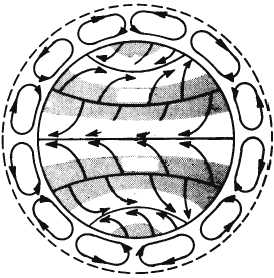Assume that a missile located at the North Pole is
launched at a target on the equator. The missile does not
have any eastward lateral velocity, but the target has an
eastward velocity of 1,000 miles per hour. The result is
that the missile appears to be deflected to the right as
the target moves away from its initial position. Refer to
view B in figure 3-4.
A similar condition assumes that a missile located
on the equator is launched at a target at the North Pole.
The missile has an eastward lateral velocity of 1,000
miles per hour, while the target on the pole has no
lateral velocity at all. Once again the missile appears to
be deflected to the right as a result of its initial eastward
lateral velocity. Refer to view C in figure 3-4.
Due to Earth’s rotation and the Coriolis effect, the
simple circulation now becomes more complex as
shown in figure 3-5. The complex on resulting from the
interplay of the Coriolis effect with the flow of air is
known as the theory. (See fig. 3-6.)
3-CELL THEORY
According to the 3-cell theory, Earth is divided into
six
circulation
belts—three
in
the
Northern
Hemisphere and three in the Southern Hemisphere. The
dividing lines are the equator, latitude, and 60°N and S
latitude. The general circulation of the Northern
Hemisphere is similar to those of the Southern
Hemisphere. (Refer to fig. 3-6 during the following
discussion.)
First, note the tropical cell of the Northern
Hemisphere that lies between the equator and 30°N
latitude. Convection at the equator causes the air to heat
and rise, due to convection. When it reaches the upper
portions of the troposphere, it tends to flow toward the
North Pole. By the time the air has reached 30°N
latitude, the Coriolis effect has deflected it so much that
it is moving eastward instead of northward. This results
in a piling up of air (convergence) near 30°N latitude
and a descending current of air (subsidence) toward the
surface which forms a belt of high pressure. When the
descending air reaches the surface where it flows
outward (divergence), part of it flows poleward to
become part of the mid-latitude cell; the other part
flows toward the equator, where it is deflected by the
Coriolis effect and forms the northeast trades.
The mid-latitude cell is located between 30° and
60°N latitude. The air, which comprises this cell,
circulates poleward at the surface and equatorward
aloft with rising currents at 60° (polar front) and
descending currents at 300 (high-pressure belt).
However, in general, winds both at the surface and aloft
blow from the west. The Coriolis effect easily explains
this for the surface wind on the poleward-moving
surface air. The west wind aloft is not as easily
explained. Most authorities agree that this wind is
frictionally driven by the west winds in the two adjacent
cells.
The polar cell lies between 60°N latitude and the
North Pole. The circulation in this cell begins with a
flow of air at a high altitude toward the pole. This flow
cools and descends at the North Pole and forms a
high-pressure area in the Polar Regions. After reaching
the surface of Earth, this air usually flows equatorward
and is deflected by the Coriolis effect so that it moves
from the northeast. This air converges with the
poleward flow from the mid-latitude cell and is
deflected upward with a portion circulating poleward
again and the remainder equatorward. The outflow of
air aloft between the polar and mid-latitude cells causes
a semi-permanent low-pressure area at approximately
60°N latitude. To complete the picture of the world’s
general atmospheric circulation, we must associate this
prevailing wind and pressure belts with some basic
characteristics.
WORLD WINDS
In the vicinity of the equator is a belt of light and
variable winds known as the doldrums. On the
poleward side of the doldrums are the trade winds; the
predominant wind system of the tropics. These easterly
winds are the most consistent on Earth, especially over
the oceans.
Near 30°N and 30°S latitudes lie the
sub-tropical high-pressure belts. Winds are light and
3-6
60O
O
O
O
30
30
60
S
N
N
S
EQUATOR
AG5f0305
Figure 3-5.—Coriolis effect on windflow.


